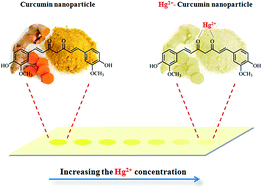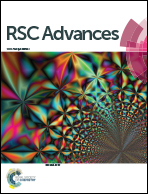Highly selective and portable chemosensor for mercury determination in water samples using curcumin nanoparticles in a paper based analytical device
Abstract
The aim of research was to employ curcumin nanoparticles (CURNs) in paper based analytical devices (PADs) for monitoring Hg2+ concentration. The wax dipping technique was utilized to create the paper based probe adding CURNs as the sensing reagent. The analytical signal was defined as the mean color intensity of each test zone which is increased upon increasing Hg2+ concentration. Some important parameters such as pH, buffer, ionic strength and multiple additions of CURNs and analyte were investigated in detail in order to establish the optimum conditions. The calibration graph was linear in the range of 0.5–20 μg mL−1 of Hg2+ with the limit of detection of 0.17 μg mL−1 (without preconcentration) and 0.01–0.4 μg mL−1 of Hg2+ with the limit of detection of 0.003 μg mL−1 (after 50 times preconcentration). The relative standard deviation for ten replicate measurements of 2 μg mL−1 of Hg2+ was 4.47%. This chemosensor was employed to analyze various water sources and satisfactory recoveries were obtained for spiked samples at different concentration levels of Hg2+.


 Please wait while we load your content...
Please wait while we load your content...